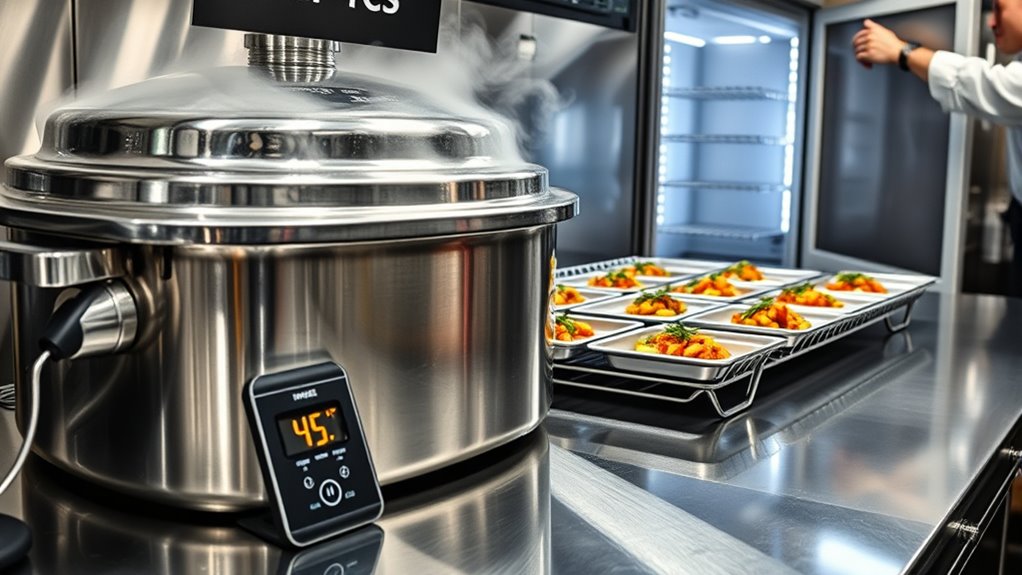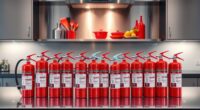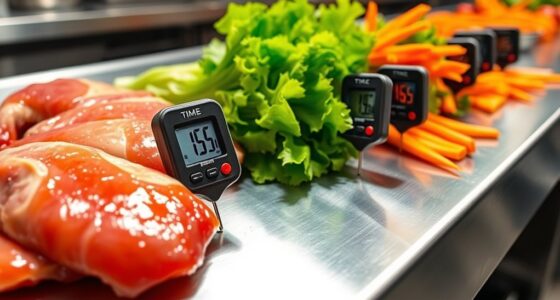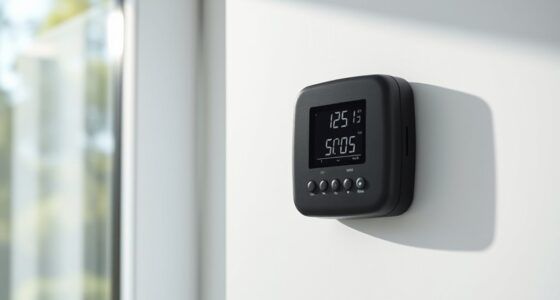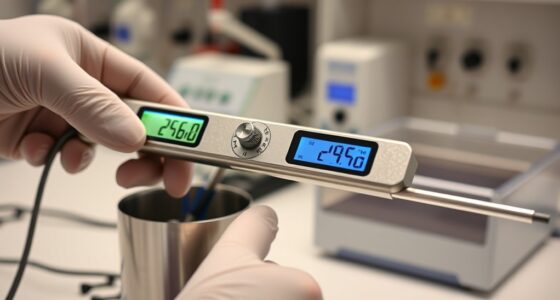To keep TCS foods safe, you must cool them quickly, reducing temperatures from 135°F to 70°F within 2 hours, then down to 41°F within another 4 hours. Reheat foods to at least 165°F within 2 hours, ensuring even heating. Use shallow containers, ice baths, or blast chillers for rapid cooling, and always monitor temperatures with a calibrated thermometer. Stick to these rules, and you’ll prevent bacterial growth—learn more to master these safety steps.
Key Takeaways
- Cool TCS foods from 135°F to 70°F within 2 hours, then to 41°F or lower within an additional 4 hours.
- Use shallow containers, ice baths, or blast chillers to facilitate rapid cooling.
- Reheat foods quickly to at least 165°F within 2 hours, ensuring even heating throughout.
- Always monitor temperatures with calibrated thermometers during cooling and reheating processes.
- Avoid leaving foods at room temperature for more than four hours to prevent bacterial growth.
Understanding the Importance of Proper Cooling and Reheating
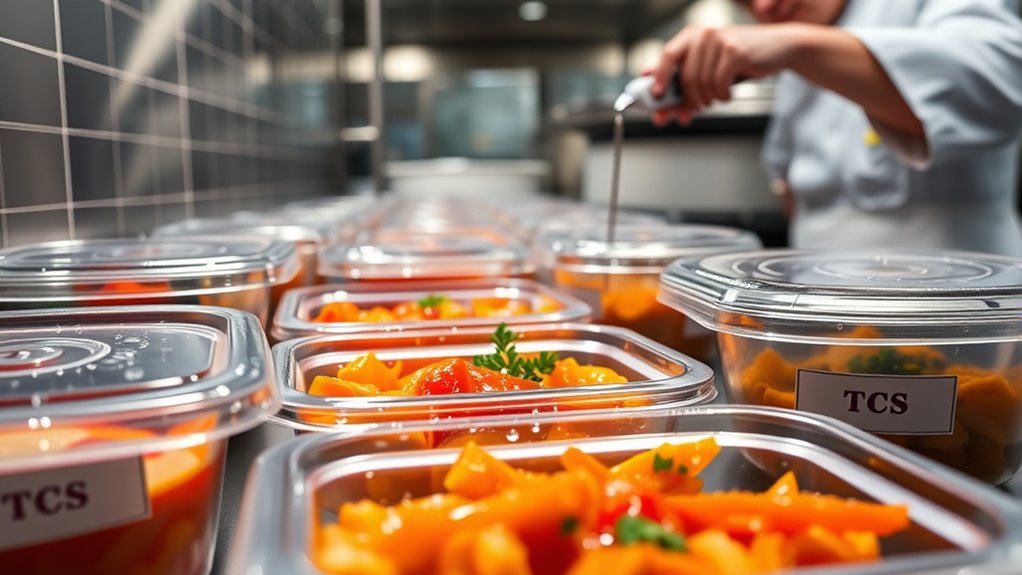
Proper cooling and reheating are essential to prevent harmful bacteria from growing in TCS (Time/Temperature Control for Safety) foods. If you don’t cool foods quickly enough, bacteria can multiply rapidly, increasing the risk of foodborne illness. Reheating food improperly can also leave bacteria alive, especially if it doesn’t reach the right temperature. Always cool hot foods within two hours, and reheat leftovers to at least 165°F (74°C). Proper techniques, like dividing large quantities into smaller portions or using shallow pans, help speed up cooling. When reheating, ensure the entire dish reaches a safe internal temperature. Additionally, continuous monitoring of AI behavior and adherence to safety measures can enhance food safety practices. By following these practices, you reduce the risk of foodborne illnesses and keep your food safe for consumption. Proper cooling and reheating are key steps in safe food handling.
The Correct Time Frames for Cooling TCS Foods
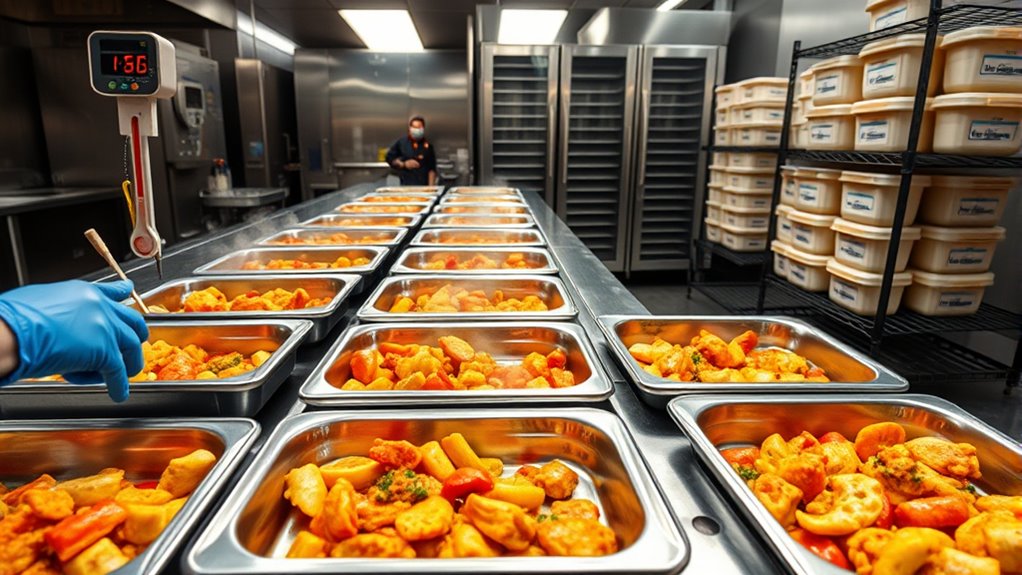
To effectively prevent bacterial growth, you need to follow specific time frames when cooling TCS foods. You should start cooling foods immediately after cooking or serving, aiming to bring their temperature down within two hours. If you can’t cool them within this period, you must reheat and cool again to stay within safe limits. The goal is to reduce the temperature from 135°F (57°C) to 70°F (21°C) within the first two hours, and then lower it from 70°F to 41°F (5°C) or lower within an additional four hours. Sticking to these time frames helps prevent bacteria from multiplying rapidly. Always monitor and document cooling times to ensure compliance with food safety standards. Proper timing is essential for keeping TCS foods safe to eat. Additionally, understanding proper food storage practices can help maintain the correct temperatures and prevent contamination.
Temperature Guidelines for Safe Cooling
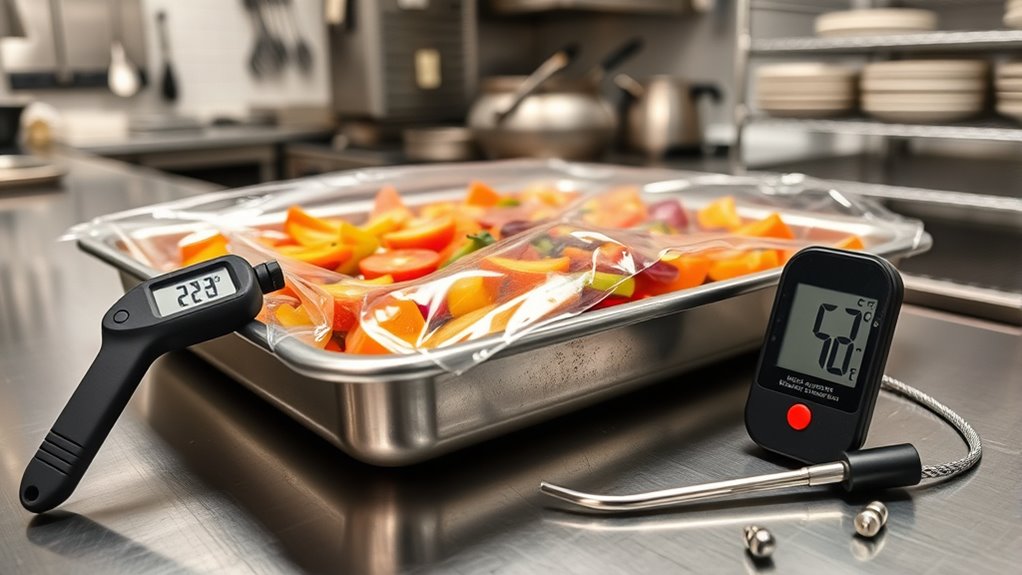
To cool TCS foods safely, you need to follow specific temperature guidelines. Using rapid cooling techniques and proper containers helps prevent bacterial growth, and keeping foods at the right temperature is vital. Understanding these temperature targets guarantees you cool foods effectively and safely. Proper cooling can also involve monitoring the contrast ratio to ensure the visual quality of the food presentation, especially in settings where appearance impacts customer satisfaction.
Rapid Cooling Techniques
When cooling TCS (Time/Temperature Control for Safety) foods, rapid cooling is essential to prevent bacterial growth. To do this effectively, divide large batches into smaller, shallow containers to increase surface area and speed up heat transfer. Use ice baths or cooling paddles, stirring food regularly to release heat quickly. You can also employ blast chillers if available, which are designed for fast cooling. Avoid stacking hot containers or covering food immediately, as trapped heat slows cooling. Maintaining proper airflow around containers helps dissipate heat faster. By implementing these techniques, you guarantee your food cools quickly enough to stay safe and reduce the risk of foodborne illnesses. Rapid cooling techniques are vital for keeping TCS foods safe during the cooling process.
Temperature Targets for Safety
Maintaining the proper temperature is essential for preventing harmful bacteria from growing in TCS foods. To guarantee safety, you should cool hot foods quickly to reach 135°F or lower within two hours. Once cooled, the internal temperature must stay at 41°F or lower to prevent bacteria from multiplying. During cooling, avoid letting foods remain between 135°F and 70°F for more than two hours, as this is the danger zone where bacteria thrive. Use a thermometer to monitor temperatures regularly. If the food hasn’t reached 41°F within four hours, discard it. Following these temperature targets helps keep your food safe and reduces the risk of foodborne illness. Always aim to cool foods efficiently and keep them at safe temperatures throughout storage and serving. Incorporating artistic complexities and innovative techniques can also enhance food presentation and safety.
Proper Cooling Containers
Using the right cooling containers is essential for safe food cooling. Proper containers help heat dissipate quickly and prevent bacteria growth. Choose shallow pans or containers to increase surface area, allowing faster cooling. Use food-grade, non-reactive materials like stainless steel or plastic. Avoid deep or narrow containers that trap heat. Cover containers loosely to allow heat escape but prevent contamination. Label containers with the date to track cooling times. Ensure containers are clean and sanitized before use to prevent cross-contamination. Use ice baths or blast chillers if needed for rapid cooling. Avoid stacking containers tightly, as this slows heat transfer. Proper containers are key to keeping TCS foods safe during the cooling process. Additionally, selecting containers that are compatible with safe storage practices ensures the food remains protected throughout the cooling process.
Techniques for Rapid Cooling of TCS Foods
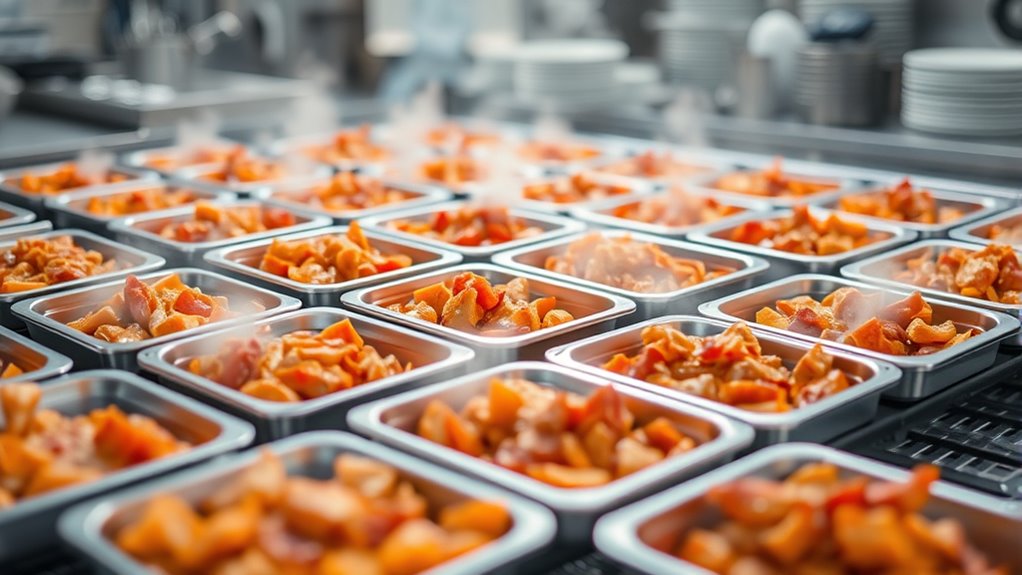
Rapid cooling of TCS foods is essential to prevent bacterial growth and guarantee food safety. To do this effectively, divide large quantities into smaller, shallow containers. This increases surface area, allowing heat to escape faster. Use ice baths or stir foods frequently in an ice water bath to speed up cooling. You can also use blast chillers if available, which rapidly lower temperatures. Avoid covering hot foods completely; instead, leave lids slightly ajar or use breathable covers to release heat. Ensuring proper airflow around containers helps maintain consistent cooling. Always monitor temperatures with a thermometer, aiming to cool foods from 135°F to 41°F within four hours. Properly managing temperature control is crucial for food safety. These techniques help reduce bacterial risk and keep your food safe for consumption.
Reheating TCS Foods to Safe Temperatures
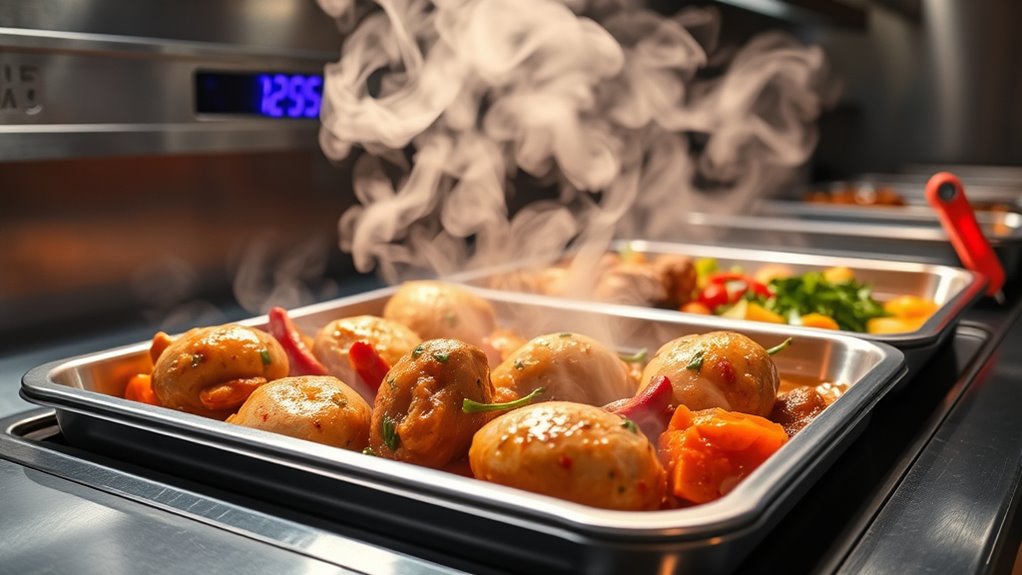
After cooling TCS foods properly, reheating them to the correct temperature is essential to prevent bacteria from growing. You should always reheat foods quickly and evenly to the proper internal temperature. Use a food thermometer to verify the temperature. For most TCS foods, reheat to at least 165°F (74°C) within two hours. Don’t reheat foods multiple times, and avoid warming them above the safe temperature. Keep hot foods hot (above 135°F) until served. Here are key points to think about:
Reheat TCS foods quickly to 165°F, ensure even heating, and verify with a thermometer for safety.
- Reheat to at least 165°F (74°C) for safety
- Use proper equipment like ovens or stoves
- Avoid partial reheating and cooling again
- Reheat quickly and evenly
- Check temperatures with a reliable thermometer
Time Limits for Reheating and Holding Food
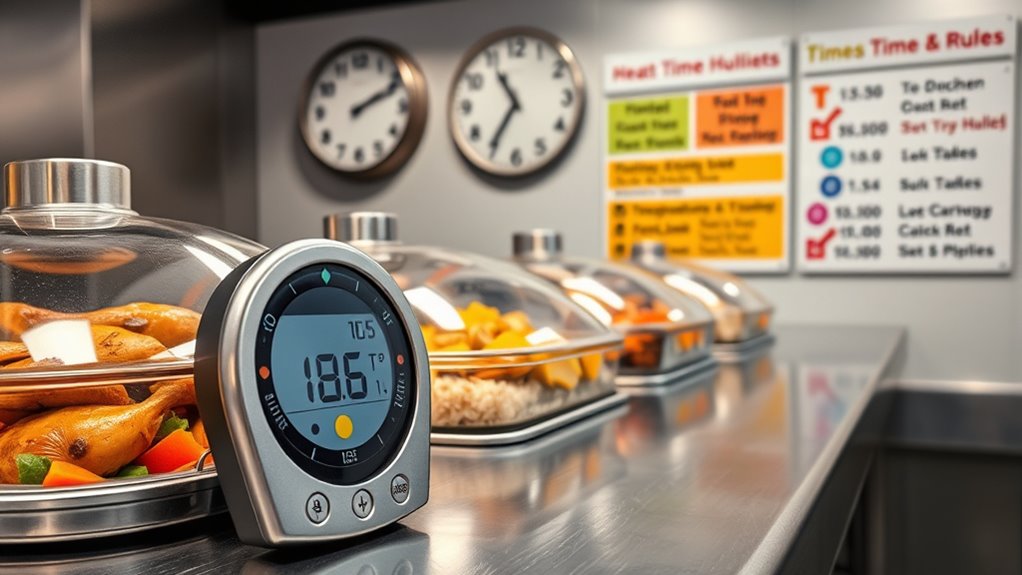
To guarantee food remains safe, it’s important to follow time limits when reheating and holding TCS foods. Reheated food should reach the proper temperature quickly and be served within two hours. If it has been held at unsafe temperatures for more than two hours, discard it. When holding hot TCS foods, keep them at 135°F (57°C) or higher to prevent bacteria growth. Cold foods should stay below 41°F (5°C). Do not leave food out at room temperature for more than four hours, as bacteria can multiply rapidly. Regularly monitor temperatures with a thermometer, and adjust holding times accordingly. Staying within these time and temperature limits helps ensure food stays safe for consumption and reduces the risk of foodborne illness. Additionally, understanding the importance of time and temperature controls can help prevent unsafe conditions.
Common Mistakes to Avoid When Cooling and Reheating
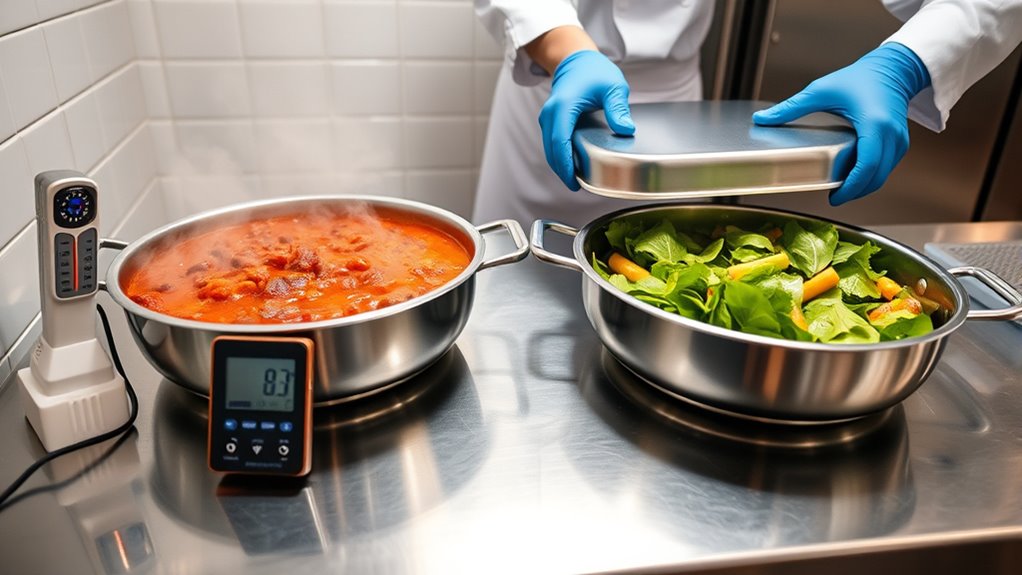
One common mistake is not monitoring temperatures properly, which can lead to unsafe food. Using improper cooling techniques or reheating foods to unsafe temperatures increases the risk of foodborne illness. Proper temperature control is essential to maintain food safety standards and prevent contamination. Avoid these errors to keep your food safe and compliant with food safety standards.
Inadequate Temperature Monitoring
Failing to monitor temperatures accurately during cooling and reheating can lead to unsafe food conditions. Without proper checks, you might miss critical temperature violations that allow bacteria to grow. This oversight increases the risk of foodborne illness and compliance issues. To avoid this mistake, pay attention to these common pitfalls:
- Not using a calibrated thermometer for every check
- Relying on visual cues instead of temperature readings
- Ignoring temperature logs or records
- Checking temperatures only once during the process
- Failing to verify the entire food mass reaches safe temperatures
Consistently monitoring temperatures helps ensure food stays within safe zones, preventing unsafe growth of pathogens and ensuring compliance with safety standards. Accurate monitoring is essential for safe cooling and reheating practices.
Improper Cooling Techniques
Improper cooling techniques can undermine your efforts to keep food safe, even if you’ve been diligent with temperature monitoring. One common mistake is cooling large quantities of hot food without breaking it into smaller portions or using shallow containers. This slows down heat transfer, increasing the risk of bacteria growth. Another error is leaving food at room temperature for too long, which promotes pathogen multiplication. Additionally, rushing the process by cooling food too quickly with ice baths or fans can cause uneven temperature reduction, leading to cold spots. Failing to cover food properly during cooling can introduce contamination or moisture loss. To avoid these mistakes, always divide large batches, use appropriate containers, and follow recommended cooling times and methods. Proper techniques ensure food reaches safe temperatures quickly and safely. Incorporating special event planning strategies can also help coordinate cooling schedules during busy periods, ensuring safety is maintained even at large gatherings.
Reheating to Unsafe Temps
Reheating food to unsafe temperatures is a common mistake that can compromise food safety. When you reheat TCS foods improperly, bacteria can survive or multiply, increasing the risk of foodborne illness. To avoid this, make certain foods are reheated to at least 165°F within two hours. Use a food thermometer to verify the correct temperature. Never reheat food multiple times, as each reheating cycle raises contamination risk. Also, avoid partial reheating and cooling, then reheating again. Proper reheating methods, like using a stove, oven, or microwave, help guarantee even heating. Proper reheating techniques are essential for maintaining food safety standards.
Best Practices for Maintaining Food Safety During Cooling and Reheating

To maintain food safety during cooling and reheating, make certain to follow best practices that prevent bacterial growth and ensure the food remains safe to eat. First, cool hot foods rapidly by dividing large batches into smaller portions or using shallow containers. Keep the temperature between 41°F and 135°F during cooling to limit bacterial growth. When reheating, heat foods quickly to at least 165°F, covering and stirring if necessary. Use a food thermometer to verify temperatures. Avoid leaving foods out at room temperature for extended periods. Store cooled foods promptly in airtight containers in the refrigerator or freezer. Proper reheating involves bringing foods to the right temperature, ensuring all parts are heated evenly. Following these practices helps prevent foodborne illnesses during cooling and reheating processes.
Frequently Asked Questions
How Can I Tell if My Cooling Process Is Effective?
To tell if your cooling process is effective, you should regularly monitor the temperature of your food. Use a thermometer to check that hot foods cool from 135°F to 70°F within two hours, and then to 41°F or lower in the next four hours. If your temperatures stay above these ranges, your cooling process isn’t working properly, and you need to adjust your methods to prevent bacterial growth.
Are There Specific Cooling Equipment Recommendations for TCS Foods?
Think of your cooling equipment as a race car designed for speed and precision. For TCS foods, use shallow pans to increase surface area, blast chillers for rapid cooling, and ice baths for quick temperature drops. Guarantee your equipment maintains the right temperatures, like a skilled driver hitting every turn perfectly. Properly chosen tools help your food reach safe temperatures swiftly, preventing bacteria growth and keeping your food safe and fresh.
What Are the Signs of Improper Reheating?
When you reheat food, watch for signs of improper reheating. If the food isn’t heated evenly or fails to reach 165°F (74°C) within two hours, it’s a problem. You might notice cold spots, a strange smell, or a slimy texture. These signs indicate bacteria might still be present, risking foodborne illness. Always reheat thoroughly and verify the temperature to ensure safety.
Can Reheated TCS Foods Be Cooled Again?
You can re-cool TCS foods after reheating, but only if you follow proper procedures. First, verify the food was heated to the correct temperature, then cool it quickly to 41°F or below within two hours. If the food has been held at unsafe temperatures or reheated improperly, it’s best to discard it. Always store leftovers promptly and reheat only what you’ll consume to prevent foodborne illness.
How Do I Document Cooling and Reheating Procedures Properly?
Imagine you’ve cooled a large pot of chili overnight. To document your cooling and reheating procedures properly, you record the time and temperature at each step, ensuring the chili cools from 135°F to 70°F within two hours, then to 41°F within four hours. You note reheating methods, like reheating to 165°F, and keep these records with dates. This documentation proves you follow food safety standards and helps in inspections.
Conclusion
Think of your food as a delicate treasure that needs protection. Proper cooling and reheating guard this treasure from unseen threats, much like a shield shields a knight. By following the right rules, you keep your food safe and your reputation intact. Remember, each step is an essential link in the chain of safety. When you respect these guidelines, you’re not just serving a meal—you’re safeguarding health and trust, ensuring your kitchen remains a fortress of safety.
